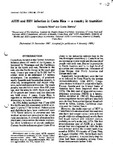Mostrar el registro sencillo del ítem
AIDS and HIV infection in Costa Rica – a country in transition
| dc.creator | Herrera, Gisela | |
| dc.creator | Mata Jiménez, Leonardo | |
| dc.date.accessioned | 2016-02-03T20:33:59Z | |
| dc.date.available | 2016-02-03T20:33:59Z | |
| dc.date.issued | 1988 | |
| dc.identifier.citation | http://www.nature.com/icb/journal/v66/n2/pdf/icb198822a.pdf | |
| dc.identifier.issn | 0818-9641 | |
| dc.identifier.issn | 1440-1711 | |
| dc.identifier.uri | https://hdl.handle.net/10669/15560 | |
| dc.description | Artículo científico -- Universidad de Costa Rica. Instituto de Investigaciones en Salud, 1988 | es_ES |
| dc.description.abstract | Costa Rica, located in the Central American Isthmus about 10' north of the Equator, is bordered by Nicaragua and the Caribbean Sea in the north and east, Panama in the east, and the Pacific Ocean in the south and west. Twenty per cent of its 51 000 km2 is arable; there is an estimated 2.7 million inhabitants. The population, of predominantly Spanish and Amerindian descent, is relatively homogeneous and enjoys religious, racial and political freedom. The death penalty was abolished more than 100 years ago, and the army in 1949. More than 90% of the people are literate and free elections are held every 4 years. Costa Rica is regarded as the most stable and prestigious democracy in Latin America. In 1986, infant mortality was 17 per 1000 live births and life expectancy at birth averaged 73 years (77 for women). Poliomyelitis and diphtheria have been eradicated since 1974. Social security is universal and free medical services are provided to the whole rural population. A network of modern hospitals and clinics serves the whole territory, but there is tolerance of private medicine. Current health indicators place Costa Rica less developed countries (1). Costa Rica has an increasing tourist trade and thousands of people visit each year. Due to its proximity to North America and to its high level of education and consumerism, thousands of Costa Ricans visit North America and Europe each year. Apparently, haemophiliacs were the first to be infected in Costa Rica by the human immunodeficiency virus (HIV). Coagulation factors VIII and IX prepared in Spain, France, Austria and the United States of America have been imported since the 1970s. The first case of acquired immunodeficiency syndrome (AIDS) in a haemophiliac occurred in 1980 (2). Presumably, some coagulation factors used in Costa Rica were derived from contaminated blood collected in Africa, Europe, Caribbean countries and the United States. However, the main reservoir of HIV in Costa Rica is homosexual and bisexual men who have had sexual contact with infected people while travelling abroad, or who have had sexual contact with infected visitors, probably as early as the late 1970s. The first autochthonous case of AIDS in a homosexual man was diagnosed in 1985; the first men infected within the country were diagnosed at INISA, University of Costa Rica, in August-October 1985. As we learn more about the epidemic, it seems likely that the virus had been circulating among Costa Rican homosexuals before 1980. | es_ES |
| dc.description.sponsorship | Universidad de Costa Rica. Instituto de Investigaciones en Salud. | es_ES |
| dc.language.iso | en_US | es_ES |
| dc.source | Immunology & Cell Biology 66: 175-183 | es_ES |
| dc.subject | Latin America | es_ES |
| dc.subject | Human Immunodeficiency virus (HIV) | es_ES |
| dc.subject | VIH/SIDA | es_ES |
| dc.subject | Acquired Immunodeficiency Syndrome (AIDS) | es_ES |
| dc.title | AIDS and HIV infection in Costa Rica – a country in transition | es_ES |
| dc.type | artículo original | |
| dc.identifier.doi | doi:10.1038/icb.1988.22 | |
| dc.description.procedence | UCR::Vicerrectoría de Investigación::Unidades de Investigación::Ciencias de la Salud::Instituto de Investigaciones en Salud (INISA) | es_ES |


